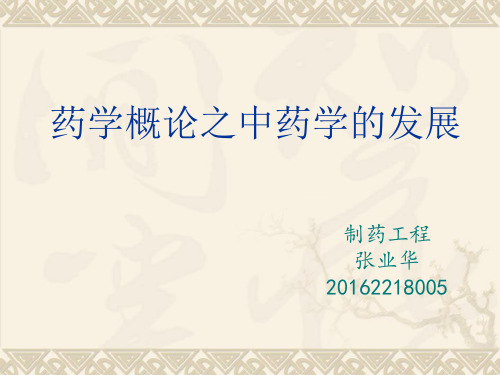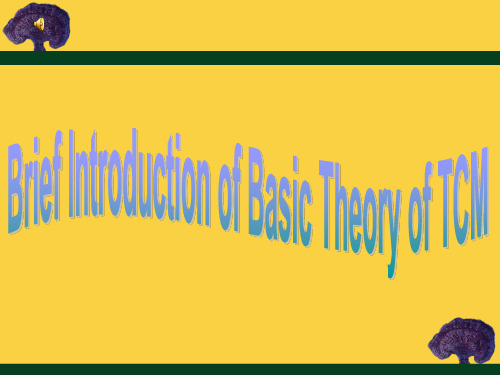药学概论之中药学的发展英文版
- 格式:ppt
- 大小:2.65 MB
- 文档页数:21



试剂、化学结构苯环取代 meta-, m- 间苯环取代 ortho-, 0- 邻苯环取代 para-, p- 对苯环取代 symetrical, sym- 均苯环取代 unsymmetrical, unsym- 偏苯环取代 vicinal,v- 连成分 cyclovirobuxine D (CVB-D) 环维黄杨星D基团 tertiary butyl 叔丁基链异构 iso- 异链异构 neo- 新链异构 normal, n- 正链异构 primary 伯链异构 quaternary 季链异构 secondary, sec- 仲,另链异构 tertiary, ter-, tert- 叔,特手性异构 dextro, d- 右手性异构 laevo, l- 左手性异构 meso- 内消旋手性异构 Rectus, R- 右,顺时针手性异构 Siniter,S- 左,逆时针顺反异构 cis- 顺顺反异构 cis-isomer 反式体顺反异构 Entgagen, E- 相反顺反异构 trans- 反顺反异构 trans-isomer 顺式体顺反异构 zusammen, Z- 共同2-Butanone 2-丁酮2-methylprapanoate, isobutyrate 2-甲基丙酸酯4-benzoylphenol 4-羟基二苯酮;4-羟基苯基苯甲酮;(4-羟基苯基)苯基甲酮;4-羟基二苯甲酮absolute ethanol 无水乙醇(含水量1%以下)acetal 乙缩醛,乙缩醛二乙醇,俗称塑钢(港台地区有称:塑胶钢) acetaldehyde 乙醛acetate buffer 醋酸盐缓冲液acetic anhydride 醋酸酐,又称醋酐、乙酐、乙酸酐acetone 丙酮acetonitrile 乙腈,别名甲基氰acetophenone 苯乙酮acetyloxy 乙酰氧基acidified water 酸化水activated carbon, activated charcoal 活性炭Adrenaline 肾上腺素Adsorption indicator (Adsorb)吸附指示剂albendazole 阿苯达唑aldehyde free alcohol 无醛乙醇aliphatic 脂肪族的alkali hydroxide 氢氧化碱alkaline solution 碱性溶液alkyl 烷基,烃基alkyl aryl ether 烷基芳基醚alkylene 烯烃基alkyne 炔Aminoalkyl Methacrylate Copolymer E (Eudragit E100) 甲基丙烯酸氨烷基酯共聚物E型aminobenzoic acid 氨基苯甲酸aminoethoxymethyl 氨乙氧甲基aminoheptane 氨基庚烷aminophenol 氨基苯酚aminophenyl 氨(基)苯(基)aminosalicyclic 氨基水杨酸aminosalicylate 氨基水杨酸盐Aminothiophenol 氨基硫酚Ammonio Methacrylate Copolymer Type A (Eudragit RL 100) 季胺基甲基丙烯酸酯共聚物A型Ammonio Methacrylate Copolymer Type B (Eudragit RS 100) 季胺基甲基丙烯酸酯共聚物B型ammonium chloride 氯化铵ammonium hydroxide 氢氧化铵,即氨水。



中医药文化的起源和发展英语作文The Origin and Development of Traditional Chinese Medicine CultureIntroduction:Traditional Chinese Medicine (TCM) has a long history of more than 2000 years and has become an important part of Chinese culture. It includes various practices such as acupuncture, herbal medicine, and massage therapy, and has been widely practiced in China and other parts of the world. The origin and development of TCM culture are closely related to the rich historical background and philosophical traditions of China.Origin of TCM Culture:The origin of TCM culture can be traced back to ancient China, where primitive tribes began using natural herbs and plants to treat diseases. Over time, these practices were further developed and refined by successive generations of scholars and practitioners. The earliest recorded works on Chinese medicine can be found in the Yellow Emperor's Inner Canon, a classic medical text dating back to the 2nd century BC. This text laid the foundation for the theory and practice of TCM, emphasizing thebalance between Yin and Yang, the five elements, and the flow of Qi in the body.Development of TCM Culture:Over the centuries, TCM culture continued to evolve, incorporating new ideas and practices from other cultures while retaining its core principles. During the Tang and Song dynasties, TCM underwent a period of great development, with the establishment of medical schools, hospitals, and the publication of numerous medical texts. Acupuncture, herbal medicine, and other TCM practices gained widespread popularity and acceptance among the Chinese population.In modern times, TCM culture has faced challenges from Western medicine and scientific skepticism. However, many people around the world are still turning to TCM for alternative therapies and holistic treatments. In recent years, the Chinese government has made efforts to promote TCM culture by establishing research institutes, standardizing practices, and integrating TCM into the national healthcare system.Cultural Significance of TCM:TCM culture is not just about treating illnesses; it is also a reflection of Chinese philosophy, cosmology, and culturaltraditions. TCM emphasizes a holistic approach to health, viewing the body as a microcosm of the natural world and the universe. This interconnectedness is reflected in the use of natural herbs, acupuncture, and other treatments to restore balance and harmony to the body.TCM culture also has a strong influence on Chinese art, literature, and philosophy. Traditional Chinese paintings often depict scenes of doctors and patients, herbal medicine gardens, and the five elements of nature. Poems, stories, and philosophical texts reference TCM concepts such as Yin and Yang, Qi, and the harmony of the mind, body, and spirit.Conclusion:Traditional Chinese Medicine culture has stood the test of time and continues to be an important part of Chinese heritage and identity. Its origins can be traced back to ancient times, and its development has been shaped by centuries of knowledge, wisdom, and practice. TCM culture embodies the rich cultural traditions and philosophical insights of China, offering a unique perspective on health, wellness, and the human experience. As TCM continues to gain popularity and recognition around the world, it serves as a bridge between East and West, ancient and modern, traditional and contemporary approaches to healthcare.。
医药发展史英语作文Title: The Evolutionary Journey of Medicine: A Brief Overview.The history of medicine is a vast and fascinating tapestry, spanning across centuries andcontinents,intertwined with the threads of human curiosity, struggle, and innovation. It is a narrative that begins with primitive practices and evolves into a complex and sophisticated field, shaping the way we understand and approach health and illness today.Early Beginnings.The earliest forms of medicine can be traced back to ancient civilizations such as Egypt, Greece, China, and India. These cultures were marked by a blend of mysticism, superstition, and rudimentary understandings of the human body and its ailments. Practices such as bloodletting, herbal remedies, and prayers to deities for healing werecommon.The Egyptians, for instance, had an elaborate system of medicine based on the belief that good health depended on the balance of bodily humors. They used a range of herbal remedies and incantations to treat various ailments. Similarly, the Greeks attributed illness to imbalances in the four elements earth, air, fire, and water and their interaction with the body's humors.The Rise of Rational Medicine.The Greco-Roman period marked a significant shift towards a more rational and scientific approach to medicine. The works of Hippocrates, considered the father of modern medicine, emphasized the importance of observation and reasoning in diagnosing and treating diseases. Histeachings强调通过观察和推理在诊断和治疗疾病中的重要性,强调预防胜于治疗,并奠定了以患者为中心的医学伦理基础。
中药学类英文作文In the vast and profound realm of medical knowledge, Traditional Chinese Medicine (TCM) stands as a unique and enriching discipline. Encompassing a blend of ancient wisdom, natural philosophy, and therapeutic practices, TCM offers a holistic approach to healthcare that harmonizes with the rhythms of nature and the intricacies of the human body.The foundation of TCM is rooted in the ancient texts of the "Yellow Emperor's Classic of Internal Medicine" and the "Canon of Medicine," which detail the principles of Yin and Yang, the Five Elements, and the theory of Qi (pronounced "Chi"). These principles form the backbone of TCM's diagnostic methods and therapeutic interventions, guiding practitioners in their understanding of health and disease. Yin and Yang, the dual forces that govern all natural phenomena, are seen as the balance of opposing yet complementary forces within the body. When this balance is disturbed, it leads to illness or disharmony. The Five Elements - Wood, Fire, Earth, Metal, and Water - represent different aspects of the universe and their interactionswithin the human body. Qi, the vital energy that flows through the body, is essential for maintaining good health. TCM's diagnostic methods differ significantly fromthose of Western medicine. Instead of relying solely on modern technology, TCM practitioners assess a patient's health through observation, auscultation, olfaction, inquiry, and palpation. This comprehensive approach allows practitioners to gain a deeper understanding of thepatient's condition, taking into account their physical, emotional, and environmental factors.Therapeutic interventions in TCM are as diverse as they are numerous. Herbal medicine, acupuncture, moxibustion, cupping, and massage are just a few examples of the modalities employed by TCM practitioners. These therapies aim to restore balance to the body by addressing the underlying causes of illness, rather than just treating the symptoms.Herbal medicine, in particular, is a cornerstone of TCM. Chinese herbs are selected based on their properties and actions, which are often tailored to the individualpatient's needs. These herbs can be administered asdecoctions, powders, pills, or pastes, and are often combined with other herbs to create formulas that address specific conditions.Acupuncture, another signature therapy of TCM, involves the insertion of fine needles into specific points on the body to regulate the flow of Qi. This ancient technique has been shown to effectively treat a wide range of conditions, from chronic pain to emotional disorders.The beauty of TCM lies in its adaptability and customizability. Its therapies can be tailored to theunique needs of each patient, taking into account their age, gender, constitution, and environmental factors. This personalized approach to healthcare is increasingly being recognized and appreciated in the global medical community. In conclusion, Traditional Chinese Medicine offers arich and profound understanding of health and disease. Its holistic approach, emphasis on prevention, and个性化治疗方法 make it a valuable addition to modern healthcare systems. As the world increasingly turns towards natural and sustainable methods of healthcare, the enchanting world of TCM continues to captivate and inspire.**中药学的魅力世界**在医学知识的广阔与深邃领域中,中药学(TCM)作为一种独特而丰富的学科,独树一帜。
中医药文化的起源和发展英语作文{z}Title: The Origin and Development of Traditional Chinese Medicine CultureTraditional Chinese Medicine (TCM) is a comprehensive system of healthcare that has been practiced for thousands of years.It encompasses various theories and practices, such as herbal medicine, acupuncture, massage, and qigong, which aim to promote balance and harmony within the body.The origin and development of TCM culture can be traced back to the ancient Chinese, who observed the natural world and sought to understand the interrelationships between humans and their environment.The origins of TCM can be traced as far back as the Yellow Emperor"s Classic of Medicine, which is thought to have been written around 2,500 years ago.This classic text provides a comprehensive overview of the principles and practices of TCM, including the concepts of yin and yang, the five elements, and the theory of channels and meridians.These concepts form the foundation of TCM and are still widely used today.Throughout history, TCM has continued to develop and evolve.During the Tang and Song dynasties, TCM gained more prominence, and many famous physicians and herbalists emerged during this time.They made significant contributions to the development of TCM, including the compilation of medical encyclopedias and the discovery ofnew herbal remedies.In more recent history, TCM has gained international recognition, and its practices have been integrated into healthcare systems around the world.The World Health Organization (WHO) has recognized the effectiveness of certain TCM treatments, and many countries have established TCM schools and hospitals to promote the study and practice of TCM.Despite its long history and wide acceptance, TCM still faces challenges in the modern world.Critics argue that TCM lacks scientific evidence and that its practices are outdated.However, many researchers and healthcare professionals believe that TCM can complement modern medicine and offer alternative treatments for various conditions.In conclusion, TCM culture has a long and rich history, dating back thousands of years.It has evolved and developed over time, and its practices have been embraced by many cultures around the world.Despite challenges faced in the modern world, TCM continues to be practiced and studied, offering a unique perspective on healthcare that emphasizes balance, harmony, and the interconnectedness of humans and nature.。
中药学的英语English:Traditional Chinese Medicine (TCM) is a comprehensive system of healing that has been practiced for thousands of years in China and other parts of East Asia. It encompasses various modalities including acupuncture, herbal medicine, cupping therapy, moxibustion, and dietary therapy, all aimed at restoring the balance of qi, or vital energy, within the body. TCM operates on the principle that health is a harmonious balance between the opposing forces of yin and yang, and that illness arises when this balance is disrupted. Diagnosis in TCM involves a holistic assessment of the patient's symptoms, medical history, and constitution, often incorporating methods such as pulse and tongue diagnosis. Herbal medicine is a central component of TCM, with thousands of herbs categorized by their energetic properties and therapeutic actions. These herbs are often prescribed in complex formulas tailored to each individual's specific needs. Despite being rooted in ancient philosophy and practices, TCM has garnered increasing interest and recognition in the Western world for its holistic approach to health and its effectiveness in treating a wide range of conditions. However, there remainchallenges in integrating TCM with Western medicine due to differences in conceptual frameworks and standards of evidence.中文翻译:传统中医学(TCM)是一个综合性的治疗体系,在中国和东亚其他地区已有数千年的历史。